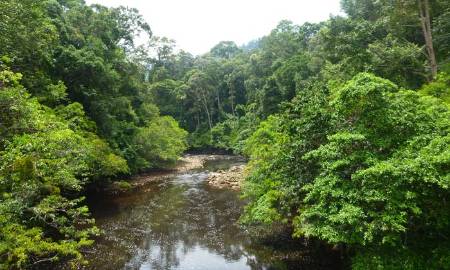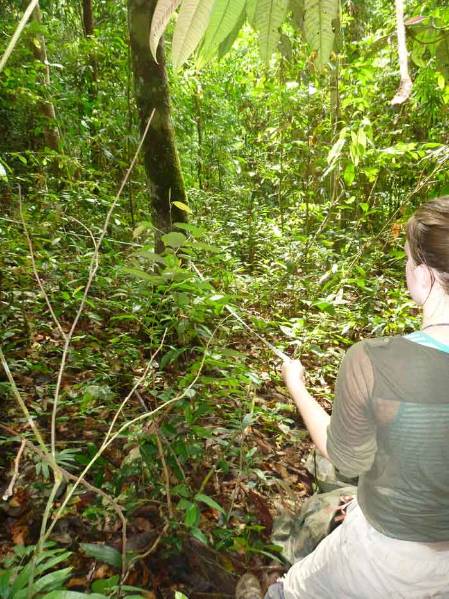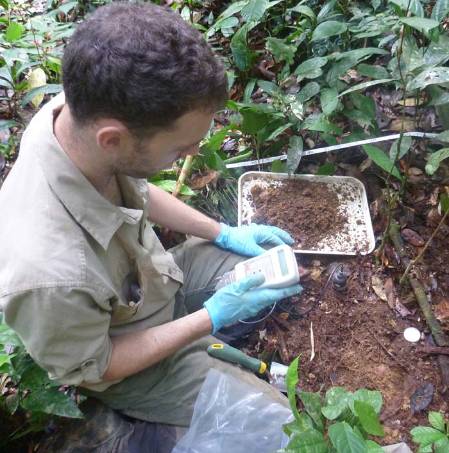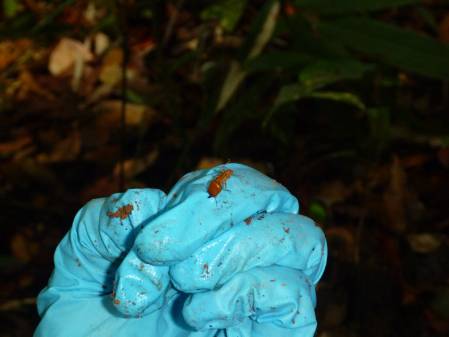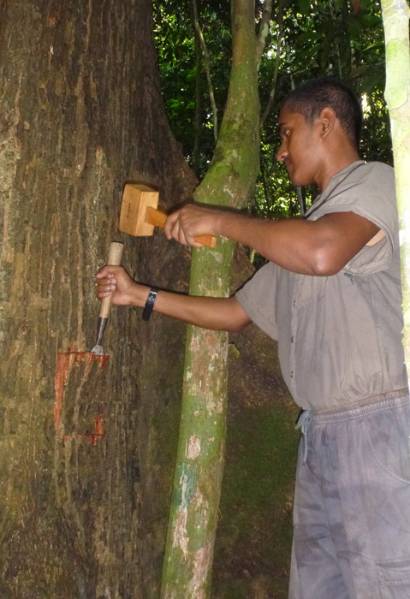Kerry and I got up at 5am this morning in the hope of seeing gibbons! Brandishing torches, we stumbled out of our dormitory and into the darkness, heading towards the swing bridge that crosses the Maliau River. We’d heard gibbons calling from this area before, and thought we might have a better chance of seeing them in the early morning, when it’s a little cooler and wildlife in general tends to be more active.
The Maliau River.
No such luck. We sat on the bridge for over an hour, with a no sign of the elusive gibbons. But it did give us the opportunity to hear all the other animals waking up and producing their morning calls.
After breakfast (a mixture of cereal, rice, chicken nuggets and small sausages) I followed Kerry as she sampled the dead wood along the transect line on today’s site/plot. The transect line is laid out at each site and is 100 metres long. It is along this line that the scientists sample the leaf litter and soil at set intervals, as well as studying any dead wood found between the start and end point.
Kerry holds onto one end of the measuring tape as the team lay out their transect line.
Dan and his team also measure the temperature and water content of the soil (how much moisture is in it) and look carefully at what type of soil is found along the transect line. These are all important factors that will influence the type of plants and animals that are found in a given area.
Keiron uses a thermometer and a soil moisture meter.
Dead wood provides an important shelter and food source for some species of invertebrate.
Amongst the numerous animals that Kerry found in her dead wood samples, there was a particularly bold soldier termite that tried to bite her finger!
Fortunately Kerry’s gloves gave her some protection against this feisty soldier termite.
Kerry also found a scorpion in a piece of dead wood further down the transect line. Good reason for always being cautious when sampling!
It’s not unusual to find scorpions sheltering in dead wood.
Also joining us in the field today were local collaborators from the University of Malaysia, Sabah (UMS). They are working closely with Pat and Holger to study the lichens here. Professor Charles Vairappan is a Natural Product Chemist and interested in analysing the chemicals that different species of lichens produce.
Research suggests that Lichens produce chemicals for various reasons. Some chemicals help lichens avoid predation from animals (such as springtails, mites, snails, slugs and caterpillars), while other substances protect the lichens from UV light or excessive light intensities. A unique property of some lichen chemicals is their water repellent function (like a biological Gortex) which helps to prevent them from ‘drowning’ (remember the film footage of the rain in my Day 5 blog?)!
This is the lichen I mentioned yesterday, Herpothallon ‘woolly’, which contains interesting chemicals that are essential for identification.
But what’s particularly interesting is the diversity of these chemicals. Different lichens produce different chemicals, and this information could therefore be used to assist with the identification of lichens (alongside morphological descriptions (what a species of lichen looks like, both the outer and inner structure) and DNA analysis.
By identifying the unique chemicals of the different lichens, Charles will contribute to the description and identification of tropical lichens that Pat and Holger are working on.
Charles is also interested in why some species of tree in the rainforest have very few lichens living on their bark, while other species are covered in lichens. This may be due to chemicals that are produced in the bark of the tree, but no-one has studied what these chemicals are.
Charles explains the two areas of lichen research that he is focusing on.
One of Charles’ students, Kishneth, is collecting sections of tree bark (from the same trees that Pat and Holger are sampling), so that they can be analysed in the laboratory. Requiring a chisel and hammer and a good deal of strength, it’s hard work, but the results from the chemical analysis should be fascinating.
Kishneth removes a small piece of bark from each tree for analysis.



